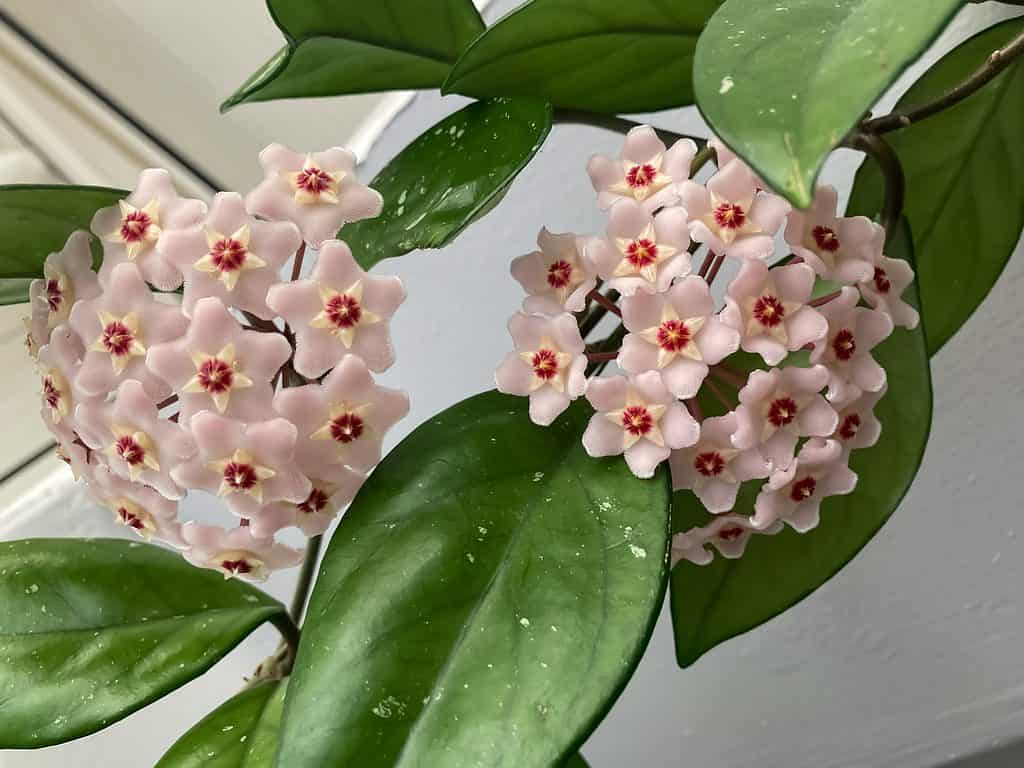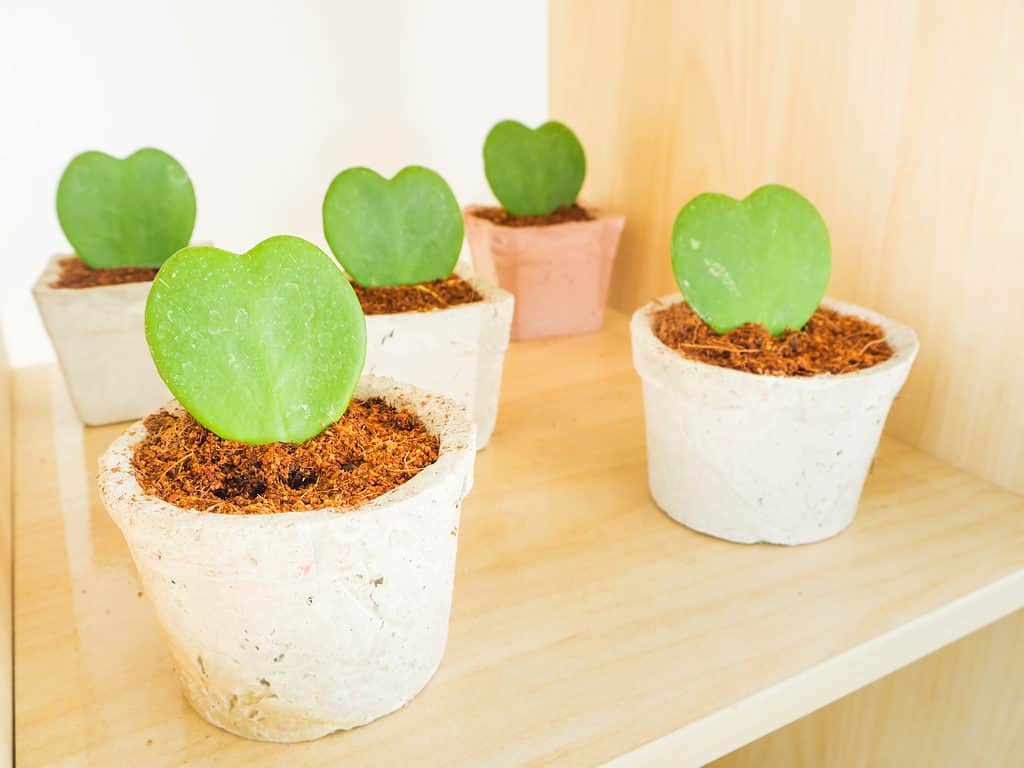Hoyas are easy-going, low-maintenance plants, making them extremely popular among beginner and expert gardeners alike. They are well-known for their fragrant, stunning flowers and (often) waxy foliage. Hoyas are part of the Apocynaceae family and boast over 500 unique species! They are native to tropical and subtropical regions like Southeast Asia, Australia, and the Pacific Islands. Every hoya is unique and offers its own collection of show-stopping flowers and leaves. They will grow successfully outdoors in Zones 10 and 11. However, it is more common to find hoyas indoors. So, if you want to grow your hoya plant indoors, there are some tips and tricks to get you started.
Choosing Your Hoya
With over 500 species of hoya available to choose from, where do you even start with this task? An easy way to stick your toe in the proverbial waters is to go to your local nursery. They likely have at least a small selection of hoya plants for you to pick from. And if you have questions about their specific care needs, you have someone right there to help you.
However, it would help if you take time beforehand to peruse online and see if a variety speaks to you. That way, you can start to narrow your search. Learning about any particular watering or lighting requirements is important to help your hoya live a long, thriving life.
To help you narrow your search a little more, here are a few types of hoya that you may want to consider.
- Hoya carnosa
- Hoya pubicalyx
- Hoya kerrii
- Hoya kentiana
- Hoya curtisii
- Hoya compacta ‘Variegata’

is a fantastic option thanks to its lovely flowers.
©gubate/Shutterstock.com
Finding the Right Location
Once you have chosen your new hoya plant, you should select a suitable location. All hoya plants thrive in indirect (but bright) light. They need at least six hours of quality sunlight daily to truly thrive. However, some varieties can also grow in low-light or shaded conditions. But keep in mind that these conditions are not optimal for a hoya plant’s growth, so your plant may grow slower than expected. It is vital to keep them out of direct sunlight. Too much exposure can scorch their leaves.
If you don’t have access to enough quality light to grow your hoya indoors, consider using artificial light or grow lights. This method is a great supplement to any natural light in your home or office. However, if you add grow lights, your hoya plant will need additional exposure. Plan on offering at least eight hours of indirect light under those conditions.
Selecting a Container
Choosing the proper container is also vital for the successful growth of hoya plants. All hoya plants prefer to be slightly root-bound, which is good news. You can select a container that feels a little on the small side without worrying about it. Additionally, a small pot will help prevent overwatering. And that is extremely important. Overwatering hoya plants will result in root rot, killing your plant. You also want to ensure the container you select has adequate drainage holes so excess water can drain.

Hoya plants prefer cozier, tighter pots.
©KelenOlga/Shutterstock.com
Picking the Soil
Choosing the appropriate soil for your new hoya plant is critical for its growth. Hoya plants prefer loose, well-draining soil that is slightly acidic. An ideal potting medium for hoya plants will contain perlite, peat moss, and vermiculite. Avoid using heavy garden soil or soil mixes that retain too much water, which can lead to root rot. You can also purchase a potting mix specifically designed for cacti and succulents.
Watering Your Indoor Hoya
As you may have gathered, hoyas do not like to get overwatered. In fact, they are drought-tolerant, so your watering job is much easier. During the winter, there is no need to water the hoya until the soil has completely dried out. However, your plant will need more water in the spring and summer. When the top 2 inches of soil dry out, it is time to water your new hoya.
How Much Humidity Does a Hoya Need?
Since hoya plants are native to the tropics and subtropics, they like high humidity levels. If they are not kept moist enough, the flowers won’t blossom. Try to find a spot that offers moderate to high humidity levels. However, if that is not available, don’t worry. There are a few tips to help keep your hoya healthy. Try misting your plant regularly or placing a humidifier nearby. Or, you can stick a tray of water near your plant to help increase humidity.
Fertilization
Fertilizing hoya plants regularly during the growing season is important for their successful growth and flowering. They are relatively light feeders, so they don’t need much. Once a month during the spring is summer is enough. And they don’t need fertilizer during the winter. Select a balanced, water-soluble fertilizer for the best results.
Pruning Your Indoor Hoya
When you grow a hoya indoors, you may have limited space for the trailing vines. So pruning will be an essential part of your routine. But there is another benefit to pruning. It helps promote bushier growth and increases flower production. The optimal time to prune is early spring before the blossoms show up. Use clean, sharp scissors or pruning shears to remove damaged, dead, or yellowing leaves. Be sure to cut just above a leaf node, as this will promote new growth. And avoid pruning any section that had flowers the previous year, as the flowers return to the same spot annually.
Propagating Hoyas
After you have brought one hoya home, chances are high you want another one. And the best part is that hoyas are easy to propagate, so you don’t have to run back to the nursery. You can propagate them by stem cuttings or layering.
To propagate via stem cuttings, take a roughly 4 to 6-inch piece of stem with multiple leaves attached. Remove any lower leaves, and place the stem in a glass of water or plant it into a new container. It will take a few weeks for the new root system to develop.
To propagate via layering, you will bend one stem over and cinch it down to the soil in a second pot. However, leave it attached to the parent plant. Water it gently for a few weeks until the root system starts to develop. Once the new roots have grown, you can gently cut them away from the parent plant.

Sweetheart hoyas are commonly sold as individual stem cuttings.
©Supachita Krerkkaiwan/Shutterstock.com
Pest Control
Thankfully, when you grow hoyas indoors, pests are not as big of a concern. However, you will still want to watch out for them. Some of the more common hoya pests include spider mites, aphids, and mealy bugs. Check your plant regularly for signs of pests. You can treat your plant with insecticidal soap or neem oil.
In addition to these tips, there are a few other things to be aware of when growing hoya plants indoors.
- Avoid repotting hoyas too often since they like to be rootbound. Consider repotting every 2-3 years or when the roots start popping out of the drainage holes.
- Most hoyas grow slowly, so be patient. It may take two or three years for a hoya plant to bloom, but the wait is well worth it!
- Hoyas are sensitive to sudden or drastic temperature changes. So avoid placing them near vents or in drafty areas.
- Hoya vines can get trained to grow up a trellis or support. You can use a bamboo stake or wireframe for indoor hoyas.

Long hoya vines work well in a hanging basket or attached to a trellis.
©AreePho/Shutterstock.com
The photo featured at the top of this post is © Reallyice/Shutterstock.com
Thank you for reading! Have some feedback for us? Contact the AZ Animals editorial team.






